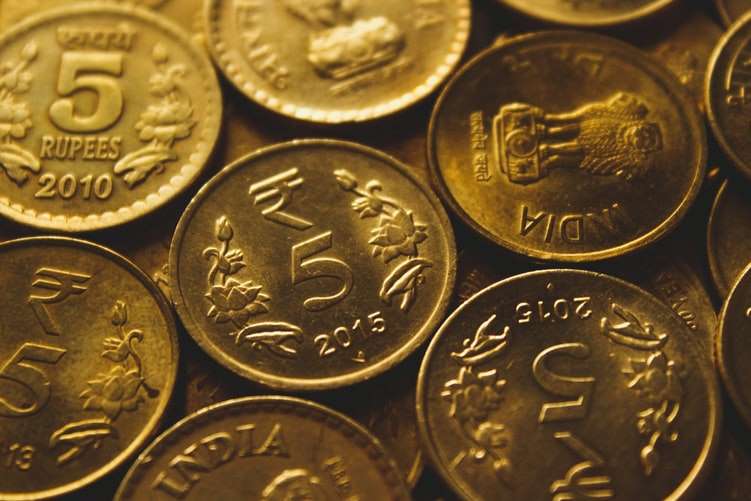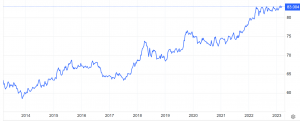
The rupee has found itself at the centre of a financial whirlwind in recent weeks with its value hitting record lows against the dollar. A confluence of factors has contributed to this precarious situation, including concerns about China’s slowing economy and the possibility of further interest rate hikes by the Federal Reserve. These issues, combined with the expectation of robust demand for the dollar due to its resilient yields, have exerted significant downward pressure on the Indian currency.
It is not all doom and gloom. The Reserve Bank of India (RBI) has stepped in with regular interventions that have effectively curbed further erosion of the rupee’s value. While the rupee touched a low of 83.21 against the dollar recently, it is worth noting that this level, though worrying, remains higher than the previous record low of 83.29 registered in October 2022. In terms of year-on-year performance, the rupee has depreciated by 1.25% in the current financial year, a marked improvement compared with the staggering 7.8% decline witnessed in the preceding fiscal year.
READ | BRICS expansion could benefit India, but at a cost
The implications of a depreciating currency are far-reaching. Chief among them is the threat of increased inflationary pressures on the Indian economy, a particularly worrisome prospect considering that inflation levels are already above the Reserve Bank of India’s comfort range. While there were hopes of easing inflation in August, driven by cooling vegetable prices, the reality is that inflation remains stubbornly above the central bank’s target range of 2-6%. The rupee’s further depreciation will exacerbate the situation by reducing its purchasing power.
Rupee vs dollar: On downward spiral

A weaker rupee also translates into higher import costs for India, a nation heavily reliant on foreign imports for crucial commodities like crude oil to meet its energy needs. With most of these import transactions settled in dollars, the rupee’s fall leads to increased expenses for the country. Moreover, a decline in the demand for Indian exports can widen the current account deficit (CAD), adding to economic concerns.
The ramifications extend to the financial sector, where businesses and the government may find it more expensive to borrow money from overseas lenders. As the rupee depreciates, the interest rates on foreign currency loans rise, presenting challenges for both the private sector and government in accessing credit.
READ I India puts Global South on top of G20 agenda
The RBI, has played a pivotal role in stabilising the domestic currency. Public sector banks have acted on behalf of the apex bank, selling dollars to prevent further depreciation. Despite these efforts, the currency market sentiment remains subdued, with no immediate catalyst for optimism on the horizon.
Looking ahead, analysts speculate about the rupee’s trajectory. While it is expected that the dollar-rupee exchange rate will surpass previous highs, reaching levels around 83.60/80 in the near term, there is a broader outlook suggesting that the rupee may breach the psychological barrier of 84 against the dollar. This possibility arises from the continued ascent of the dollar index and the weakening of Asian currencies, notably China’s yuan, which poses a threat to the Asian currency market.
The rupee’s value, however, is not solely shaped by economic factors within India’s borders. Elevated oil prices present a significant challenge, with the potential to push the currency to record lows against the dollar. This concern is magnified by the recent surge in oil prices, which has already started to weaken the rupee. Brad Bechtel, the head of global foreign exchange at Jefferies, suggests that the rupee may move within the range of 83-85 against the dollar if oil prices remain high.
Fortunately, there is a silver lining. Despite these challenges, the Indian rupee is expected to remain one of the more stable currencies within the emerging markets category. This resilience is due, in part, to India’s proactive measures to bolster its currency’s stability, including intervention in various currency markets by the RBI.
In the quest to internationalise the rupee, India has been making efforts to increase trade denominated in its currency. However, this endeavour is anticipated to be a lengthy process. While both the rupee and the Chinese renminbi vie for internationalisation, convincing other nations to hold reserves in these currencies remains a formidable challenge due to historical concerns about currency stability. Central banks will play a crucial role in ensuring the liquidity of non-dollar currency pairs for international trades, a task that may become increasingly important in the evolving landscape of global finance.
The rupee is at a critical juncture, navigating through a complex web of economic challenges and global dynamics. While it faces headwinds, its resilience, proactive measures by the RBI, and India’s efforts to bolster its role in international trade suggest that it may weather the storm and emerge as a stable currency in the turbulent seas of global finance.
